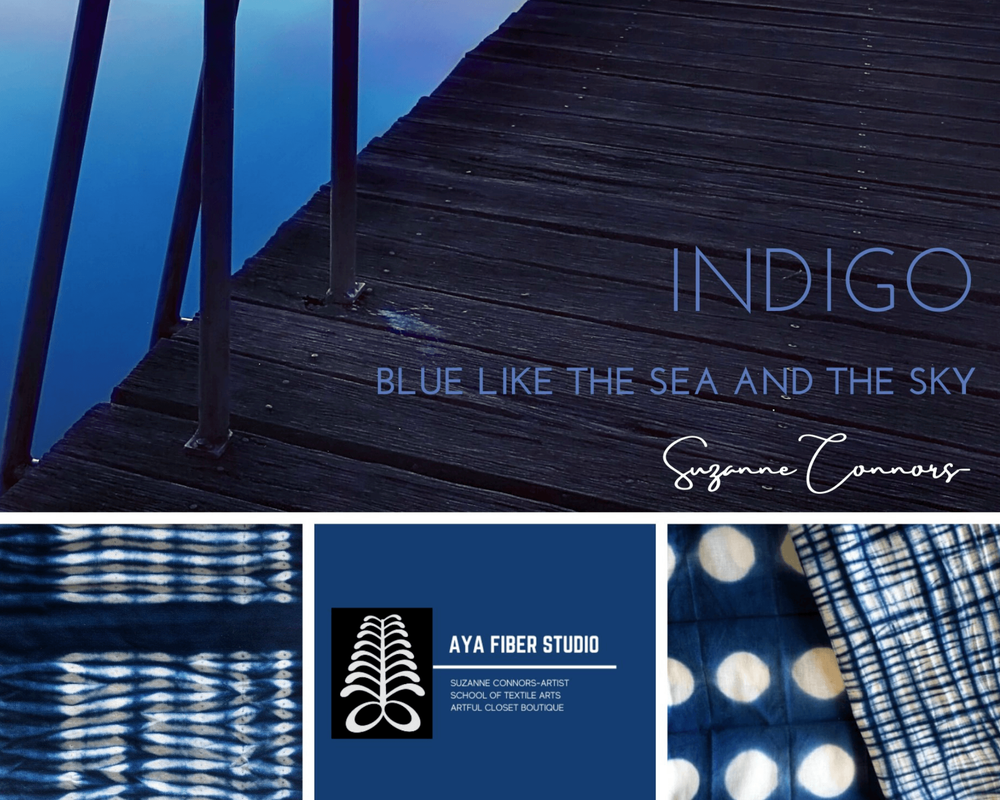IT’S NOT JUST ABOUT
CREATING; it’s
about the person you are becoming while you are creating!
Natural dyeing, indigo dyeing, Japanese textiles and shibori, batik, surface design, eco and botanical printing, sashiko, bogaji, paper and bookmaking, felting, and more. Aya Fiber Studio offers excellent live workshops taught by well-known instructors in all fiber art areas.
“I used to think there were four elements to creating something. The first is skill, then knowledge, experience, and finally a sense of beauty. Not until later in life did I realize there was a fifth element: “love”. We cannot produce large quantities. We try out new things, sometimes we succeed, and other times we fail. Everything we produce is diligently made by hand, in our fast-paced society. So if you wonder why I do what I do, I say: Because I love to create. Too many of the products nowadays are made without those 5 elements. But I believe in this day and age there has to be someone who passionately creates by hand. I hope you will be able to feel our values in our products. Every piece is unique, every surface feels different. Out of time, skill, knowledge, experience, our sense of beauty and love we create forms, colors, and patterns.”
Hiroyuki Murase
Indigo, Blue like the Sea and the Sky
Studio Calender
Blue like the Sea and the Sky
Just like the skilled hands of an indigo artisan, the blue color derived from the Japanese tade indigo plant comes in various shades. The term “Japan Blue” was coined in the 19th century by a British chemist to describe the 48 hues produced from sukumo dye. It is a remarkably versatile medium, and I would like to introduce you to my fiber workshop studio in Stuart, Florida.
The Aya Fiber Studio is located in Stuart, Florida. The owner, Suzanne Connors, has been practicing the art of aizome indigo dyeing for over 16 years. She opened her first dyeing workshop at the Fish House Art Center in Port Salerno in 2014. The Fish House was sold after COVID and the studio moved to North Stuart, at 170 NW Dixie Hwy in 2021. Suzanne produces stunning textiles, and the studio also serves a secondary purpose: to educate locals and travelers about traditional Japanese crafts and other fiber art genres through live workshops conducted by renowned artists.
There are several common methods for performing the aizome dyeing process. One technique uses hand-cut katagami stencils to apply a thick, dye-resistant paste to the fabric, which is then covered with sawdust. Dipping the fabric into the indigo dye creates a design that retains a high level of detail, known as katazome. Another method involves freehand painting with wax, which is a Japanese batik technique called rozome.
The most popular process for visitors at the Aya Fiber Studio is called shibori, which resembles the tie-dyeing technique many are familiar with. Students can use strings or rubber bands to bind the folded cloth, or they can fold and clamp the fabric with wood blocks. When applied at evenly spaced intervals or randomly, these resist bindings create patterns on the cloth. Due to the unpredictable nature of the dyeing process, inexperienced dyers may be surprised by the design that emerges after binding the fabric, adding an element of fun.
Visitors to the Aya Fiber Studio can participate in 1 to 5-day fiber art workshops. The studio offers shibori and indigo classes every month. After binding their cloth, participants begin the dipping process. Submerging the bundle into a vat of indigo and kneading it is a highly satisfying tactile experience. The first dip will turn the fabric a rich green color, while successive dips deepen the hue. Once the desired shade is achieved, the finishing process begins. The dyed fabric is rinsed and neutralized with a vinegar solution before being dried for participants to take home.
Taking an aizome workshop at the Aya Fiber Studio provides a hands-on appreciation for this unique and traditional Japanese craft. The studio also hosts workshops in natural dyeing, surface design, stitching, and other textile arts throughout the year. Additionally, it features a boutique gallery where visitors can purchase a variety of indigo-dyed and art-to-wear items in many shades of blue. The Aya Fiber Studio Workshop remains one of Stuart's most popular hands-on activities, appealing to students of all ages. Be sure to reserve your seats early, as space is limited and tends to sell out quickly!
CALL TO ARTISTS
The Exhibition will be on display at:
The Court House Cultural Center Galleries, Stuart, Florida
September 9 – November 1, 2025*
The SOUTH FLORIDA SURFACE DESIGN ASSOCIATION seeks bold, innovative contemporary fiber work and wearable art that explores unexpected relationships between fiber and other creative disciplines for Uncommon Threads: Contemporary Fiber & Wearable Art, an international exhibition that celebrates fiber as a medium that pushes boundaries and challenges expectations in contemporary art and design. Artists who utilize both traditional and non-traditional fiber materials and techniques are invited to apply. Collaborative work is welcome.
In addition to work selected from this call, Uncommon Threads will showcase masterpieces by renowned artists and feature curated works by invited fiber artists from across the country. There are two categories for submitted work, Contemporary Fiber and Art to Wear, with a total of $5,000 in cash prizes available. All formats will be considered, including 2D and 3D works and Art to Wear, including clothing, accessories, and jewelry.
Special Events: Trunk shows and lectures will be held in conjunction with the exhibition, providing additional opportunities for exposure and engagement. An online exhibition catalogue is planned.
Coffee with the Artists
Beginning 6/15/2025
6/15: Hollis Chatelain
6/22:
7/6: Makiko Tokunaga
7/13: Ana Lisa Hedstrom
7/20: Claudia Lee
7/27: Jacqueline Mallegni
8/3: Amy Nguyen
8/10: Jeanne Brady
8/17: Lorraine Glessner
8/24: DOSHI
8/31: Kevin Womak
9/7: Judith Kruger
9/14: Anne Covell
9/21:
9/28: Carol Anne Grotrain
10/5: Valerie Goodwin
10/12:
10/19: Lisa Binkley
10/26:
11/2:
11/9:





